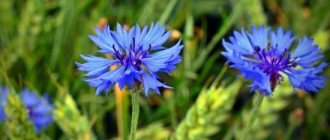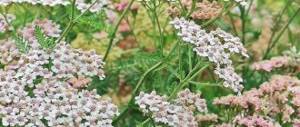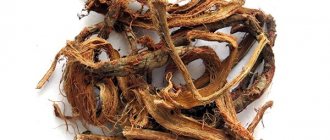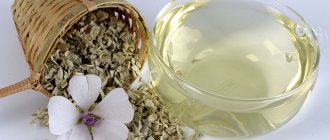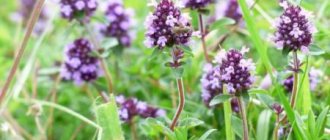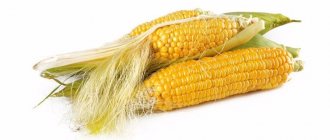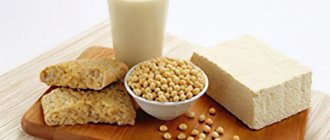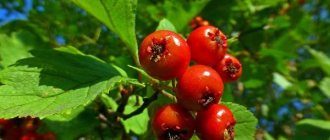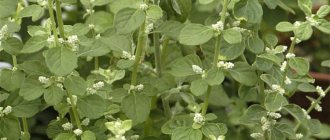Description, reproduction and distribution area of medicinal burnet
Perennial herbaceous plant of the Rosaceae family, up to 1 m high.
The rhizome is thick, woody, horizontal, up to 12 cm long with long thin roots.
The stem is hollow, ribbed, straight, branched in the upper part.
The basal leaves are large, on long petioles, odd-pinnate, with many oblong serrated leaflets. The upper stem leaves are smaller and sessile.
The flowers are small, dark red, bisexual, consisting of a four-part calyx, without petals, with 4 dark red stamens and 1 style. Collected in oval or oval-cylindrical spike-shaped inflorescences, sitting on long peduncles at the ends of the branches. The plant blooms in the 4-5th year of life.
The fruit is a dry, single-seeded, brown nut.
It blooms in June - August, the fruits ripen in August - September.
Burnet propagates by seeds (mainly) and vegetatively (by segments of rhizomes).
The lifespan of a burnet in natural conditions is up to 40 years, in crops - 7 - 8 years.
Distributed throughout Western and Eastern Siberia, the Far East, and the Urals; in the European part of the CIS it is found much less frequently.
Burnet officinalis has optimal growing conditions in meadow communities on slightly acidic, fairly rich, low- and medium-humus soils.
Burnet burnet tolerates only slight shading; with stronger shade, generative shoots do not develop.
Burnet has been known as a medicinal plant since the 16th century.
Description of the burnet
What does it look like
Burnet is a flowering plant with a strong woody rhizome, reaching a length of up to 12 cm. It produces many long and thread-like fibrous roots.
The stem is single, branching from above the redhead, reaching a height of 30 to 60 cm. Inside it is hollow and ribbed. The oval, cone-like flowers are 1-3 cm long, purple, dark red or crimson, and appear between July and August.
Large dark green leaves grow on oblong petioles and have an elongated shape with sharp edges. The upper part of the leaves is colored a darker, shiny blue. Brown and dry fruits look like nuts, 4 mm long, appear in late summer - early autumn.
Where does it grow
Burnet grows in European countries, East Asia, and North America. In Russia it prefers forest-steppe and forest zones. You can most often find this plant near bodies of water, among bushes, in swamps, in green meadows and clearings, cliffs and deep forest edges.
Chemical properties
The roots and leaves of radovik contain numerous vitamins, dyes, gallic and ascorbic acid, and starch. The roots are rich in many macroelements: potassium, magnesium, iron, calcium. They are also saturated with useful microelements, namely manganese, copper, cobalt, chromium, aluminum, zinc, barium, iodine, lead and boron.
Growing
Burnet is a fairly unpretentious plant that requires minimal conditions for care and cultivation. It is advisable to plant medicinal herbs in nutritious, well-moistened soil in partial shade. Since in its natural environment the meadow grows near bodies of water, it is necessary to ensure regular watering. Do not allow moisture to stagnate in the soil.
Collection, preparation and drying of burnet
The medicinal raw materials are rhizomes with roots (Rhizoma cum radicibus Sanguisorbae), which are harvested during the fruiting period of the plant, when it becomes noticeable in the grass by its dark red inflorescences. Dig out the plant with shovels with groove-shaped rounded blades. In order to preserve the thickets, some of the plants should be left for renewal (1-2 plants per 10 m). Repeated harvesting is carried out in one place after 10 years.
The dug up rhizomes with roots are shaken off the ground, the stems are cut off and washed in cold water. The washed raw materials are immediately laid out to dry. Then the remaining stems are trimmed to the base of the rhizomes, the latter are cut into pieces up to 20 cm long and delivered to the drying place. Before drying, they are dried in the open air, and then dried in the sun, in attics, in dryers or ovens at a temperature of 40-50 ° C. It is not recommended to dry on iron trays and sieves: the raw material turns black and loses its medicinal properties. Raw materials are considered dry if they do not bend, but break. The shelf life of raw materials is 5 years. The taste of the raw material is astringent, there is no smell.
The rhizomes and roots of burnet are harvested mainly in Siberia, where it forms significant thickets, as well as in the Urals and Tatarstan.
Medicinal properties of burnet
Modern research has proven the usefulness of Burnet. Its leaves and stems have been found to have antioxidant properties. They are able to neutralize free radicals, and therefore the use of products prepared on the basis of this plant can prevent cancer.
Judging by the name of the plant, its main purpose is to stop bleeding. Indeed, burnet tea can stop not only external bleeding, but also internal bleeding.
Use of burnet in medicine
Rhizomes with roots. Decoction, liquid extract - as a hemostatic, astringent, angiospastic, slowing intestinal motility and relieving spasms, analgesic and strong bactericidal agent; for gastrointestinal diseases (enteritis, colitis, dysentery), for internal bleeding (pulmonary, intestinal, uterine), diseases of the oral cavity (gingivitis, stomatitis, etc.).
In folk medicine, a decoction is used for diarrhea of various origins, hemoptysis, uterine bleeding; externally - for washing bleeding and festering wounds, ulcers, bedsores; in the form of lotions - for burns; rinsing - for inflammatory processes in the oral cavity; baths (sitz baths) - for hemorrhoids; douching - for inflammatory processes of the uterus, which are accompanied by bleeding.
The decoction gives a quick effect in the treatment of acute purulent conjunctivitis in children.
Powder - for dressing wounds. Tincture - for lubricating the gums.
Aboveground part. In homeopathy - hemostatic for lung diseases; in gynecology; diarrhea. In Western Europe, in addition, as a wound healing, diuretic; for malignant tumors, phlebitis, thrombophlebitis. In folk medicine externally - as a pain reliever for bruises and dislocations.
Leaves. In the Caucasus - for tuberculosis. In Yakutia - hemostatic. In the Far East - wound healing, for malignant gum tumors, they have a protistocidal effect. Used in homeopathy.
Leaves, flowers. In Central Asia - for gastrointestinal diseases, hemorrhoids.
Flowers. In Siberia - for respiratory diseases, dysentery, they have a protistocidal effect.
Burnet in folk medicine
In addition, Burnet has an astringent and anti-inflammatory property. Traditional healers suggest drinking its decoctions for diseases of the gastrointestinal tract - gastritis, stomach or duodenal ulcers, enteritis, diarrhea.
Burnet infusions are an excellent remedy for the treatment of rheumatism. They relieve inflammation and relieve pain.
Ancient healers claimed that burnet juice was capable of defeating such a terrible disease as the plague. Modern scientists decided to carefully check this assurance and came to the conclusion: indeed, the juice of the plant completely kills the virus. It has been established that burnet extract blocks the activity of pathogenic bacteria, including Staphylococcus aureus, pneumococcus, and Pseudomonas aeruginosa.
These are not all the properties of Burnet that it possesses. For example, the greens of the plant contain substances such as ellagitannins, glycosides, saponins, tannins, which reduce cholesterol in the human body.
Medicines, method of use and dosage
- Liquid extract of burnet (Extractum Sanguisorbae fluidum) in 70% alcohol is taken 30-50 drops 3-4 times a day.
- Decoction of rhizomes and roots of burnet (Decoctum rhiz. et rad. Sanguisorbae): 6 g (2 tablespoons) of raw materials are placed in an enamel bowl, pour 200 ml of hot boiled water, cover with a lid and heat in boiling water (in a water bath) for 30 minutes, cool at room temperature for 10 minutes, filter. The remaining raw materials are squeezed out. The volume of the resulting decoction is adjusted to 200 ml with boiled water. The prepared broth is stored in a cool place for no more than 2 days. Take 1 tablespoon 5-6 times a day after meals as an astringent and hemostatic agent.
- Steamed burnet herb: 3-4 tablespoons of chopped herb are wrapped in gauze, dipped in boiling water and applied to the sore spot.
Contraindications
If the dosage is observed, taking burnet will not cause harm and will not cause side effects. You should not experiment with folk remedies if you have high blood clotting.
People susceptible to allergic reactions should avoid using the drug.
In case of urgent need, perform a dermatological test: apply a swab soaked in an herbal solution to a small area of skin. If there is no irritation, feel free to use the tincture externally.
Preparations containing burnet extract are strictly prohibited for the following disorders of the body:
- If there is a blood clot.
- With high blood pressure.
- For migraines caused by hypertension.
- During pregnancy.
- Breastfeeding women.
- Children under 3 years old.
In small doses and as prescribed by a doctor, herbal infusions are recommended for children as a prevention of gastrointestinal diseases.
Use the plant in the correct dosage to avoid health problems.
Useful video
Share this post
- Related Posts
- Handmade soap for beginners: homemade recipes and sets of molds for children
- Wise quotes and statuses when your soul hurts, about loneliness and unhappy love
- Good morning wishes to friends, man and girlfriend
- TV series about vampires, werewolves and witches: list of the best
- How to properly prepare for confession, as well as a list of sins for women and men
- How to properly wash yellowed crystal until it shines
Recipes for single use of burnet in medicine
Dysentery
Gastric, uterine and hemorrhoidal bleeding
Colitis
Stomach ulcer
- Recipes for using burnet in preparations
Medicinal recipes
Hernia roots are used mainly in the form of decoctions, infusions, extracts and paraphernalia.
3 tsp. pour two cups of boiled and cooled water over the roots. You need to leave for at least 8 hours, then filter and take 100 ml before meals. You should drink the infusion not in one gulp, but in small sips, slowly.
1 tbsp. l. pour a cup of boiling water over the raw materials and steam in a water bath for half an hour, then squeeze. Drink 1 tbsp. l. after eating 4-5 r. in a day.
The same decoction can be used for headaches and tuberculosis.
A decoction prepared according to the previous recipe, but you need to leave it for 2 hours and drink 1 tbsp. l. before meals 5-6 r. in a day.
1 tbsp. l. Finely chopped roots pour a mug of water, simmer covered over low heat for 30 minutes, then let stand for 4 hours. Place the cooled roots in a gauze bag and apply to the tumor for an hour.
3 tbsp. l. roots, pour 0.3 liters of boiling water, cover and cook over very low heat for another 30 minutes. Leave for 2 hours, then cool to a warm temperature, wet the bandage and apply to the wounds for 30-40 minutes. Repeat the procedure 3-4 times. in a day.
For toothaches
Soak a small piece of cotton pad in any decoction of burnet and apply to the sore tooth and gum for 10 minutes. Repeat 3-4 times. and the pain will quickly pass.
1.5 tbsp. l. dry raw materials, pour 0.2 liters of water, bring to a boil and simmer over low heat for 10 minutes. Let it brew for half an hour, strain and rinse your mouth for up to 5 p.m. in a day.
For intestinal flu
3 tbsp. l. finely chopped roots, pour 0.75 liters of water, bring to a boil and cook for another half hour, covered and over low heat. Cool, filter and drink small sips throughout the day.
2 tbsp. l. roots, pour 0.5 liters of water, bring to a boil and simmer under the lid for half an hour, and then let it brew for 4 hours. Filter and douching. You can also insert a tampon soaked in the infusion for an hour or two. During your period you need to take a break from treatment.
2 tbsp. l. Pour the roots into a dark bottle and pour in 100 ml of vodka. Leave for 10 days in a dark place, shaking from time to time. Filter and drink 40-50 drops. 4 rub. in a day.
For conjunctivitis
1 tbsp. l. roots 15 min. simmer over low heat in a mug of water. Allow to cool, wet a cotton pad and rinse your eyes with the broth. You need to repeat up to 6 p. per day.
1 tbsp. l. pour a cup of boiling water over the roots and leave for half an hour. Drink according to? cups 3-4 r. in a day. If improvement occurs, the dose can be reduced to ? cups.
Pour 1 kg of herb into a bucket of boiling water and leave for 2 hours. Pour into a bath and take for 20 minutes. every other day, preferably before bed.
For thrombophlebitis
Powder tbsp. l. roots and pour a glass of vodka into a dark bottle and set aside for 2 weeks. Then strain and rub the affected areas 2 rubles. per day, the last one is better at night.
2 tsp. pour a cup of water over the rhizomes and cook for half an hour over the fire. Cool, strain and give the baby 25 drops 3-4 r. in a day. Children from one to three years old can be given a small spoon. Usually on the second day the stool returns to normal.
For fibroids
1. For this ailment, the following herbal collection will be useful: mix burnet and boron uterus in equal parts. Pour one large spoonful of the prepared mixture into a cup of boiling water and set aside for 10 minutes, then strain and take 1 tbsp. l. 3 r. in a day.
2. For douching, you should prepare another mixture: 1 part of burnet, boron uterus, oak bark, aspen bark, and 0.5 parts of wormwood and bergenia roots. 3 tbsp. l. Pour a liter of water over this mixture, bring to a boil, and simmer over low heat under the lid for another 30 minutes.
, then leave for 6 hours. and filter. You need to douche with this infusion twice a day, taking breaks on critical days. The same decoction can be drunk in parallel with douching, 1 tbsp. l. 3 r. in a day. A week before your period, you should stop drinking the broth.
Chemical composition of burnet
The rhizomes and roots of Burnet officinalis contain tannins (up to 40%), hydrolyzable pyrogallic group, gallic and ellagic acids, starch (about 30%), saponins, dyes, essential oil (1.8%), flavonoids: kaempferol, quercetin; the leaves contain ascorbic acid. The content of tannins in underground organs is maximum during the budding phase of the plant.
The rhizomes and roots contain: ash - 8.13%; macroelements (mg/g): K - 5.80, Ca - 23.10, Mn - 2.90, Fe -0.40; trace elements (CBN): Mg - 0.47, Cu - 0.59, Zn - 1.02, Co - 0.04, Cr - 0.03, Al - 0.31, Ba - 5.71, V - 0 .12, Se - 1.39, Ni - 1.15, Sr - 6.14, Pb - 0.06, I - 0.10. B - 2.00 µg/g. Mo, Cd, Li, Au, Ag, Br were not detected. Concentrates Zn, Ni, Sr, Se, Ba, especially Ba, Sr.
pharmachologic effect
Burnet is a tall perennial herbaceous plant with large basal leaves and small dark red flowers.
We recommend reading: Is it possible to eat salted lard while breastfeeding?
Burnet grass grows mainly in damp places - along river banks and in flood meadows. Blooms throughout the summer.
In medicine, the rhizomes and roots of burnet are widely used, which are collected from summer to autumn. The collected, washed and air-dried roots are dried in ovens. The rhizome and root of Burnet contain ellagic and gallic acids, tannins, catechin and gallocatechin, vitamin C, pyrogallol, as well as flavonoids, saponins and other substances. It has a hemostatic, antidiarrheal, anti-inflammatory, uterotonic, enveloping, vasoconstrictive, antiseptic and astringent effect.
According to the ancient tradition, children were treated for neurological diseases with burnet. The aroma of the herb was believed to bring health and longevity.
Growing and cultivating Burnet officinalis
Burnet is responsive to fertilizing with organic and mineral fertilizers. In early spring, after the snow melts, complex mineral fertilizers are scattered at the rate of 30-40 g per 1 m and lightly sprinkled with earth, since the root system of the plant is located in the surface layer of soil. The same amount of fertilizer is applied before sowing the seeds. They are sown in holes or rows at a distance of 15-20 cm, watered and sprinkled with a mixture of earth, sand and peat in equal proportions.
It is recommended to sow in spring with seeds that have undergone two-week stratification (when stored indoors, the seeds remain viable for 1.5 years). During the growing season, the soil around the plants is kept loose and free of weeds. In the second year of cultivation, the mass of underground organs of one specimen reaches 17-27 g. The yield in the culture is up to 20 c/ha.
How to apply it correctly?
Burnet is used externally and internally. It is worth highlighting the effect of the herb on the female reproductive system. The plant is able to stop any internal and external bleeding.
Advice! To stop external bleeding, the herb is used externally. To stop internal processes, the tincture is taken drip-wise as prescribed by a doctor.
In its medicinal properties, burnet can be compared only with the hog queen. The plant also has wound healing properties.
For women, the herb is used as an anti-inflammatory medicine. The decoction is used for washing the vagina or for internal use.
Herbal infusions will help women from the following ailments:
- With increased abundance of menstrual flow.
- For intrauterine bleeding.
- After surgery and termination of pregnancy.
- For inflammatory processes in the uterus and appendages.
- For erosive formations on the cervix.
Important! Before using a pharmacy tincture, consult a gynecologist and carefully read the instructions.
The second main advantage of the plant is its antidiarrheal effect. Thanks to its rich bactericidal composition, burnet will help normalize the intestinal microflora, stopping diarrhea.
The natural remedy can be used by both children and adults.
You can prepare the tincture yourself from a fresh or dry plant. When using a pharmacy product, read the instructions to correctly calculate the dosage based on your weight and age.
Familiarize yourself with the features of using various forms of medication in the table:
| Release form | Description | Features of application |
| Menzies Tincture | Ready-made alcohol tincture | To stop internal bleeding, prescribe 30-60 drops three times a day. The medicine can be taken with water. Externally the drug is used for douching |
| Burnet root | Dry plant | Grind the root, pour a glass of boiling water. The decoction should steep for 2 hours. For 250 ml of hot water you need 30-40 g of herb. Prepare a new mixture every day, drink the product during the day, dividing it into 4 doses |
You can prepare an alcohol tincture yourself. To do this, pour crushed leaves and burnet root with vodka or alcohol. Infuse the mixture for 3 weeks, shaking the container periodically.
Important! To prepare homemade decoctions, use high-quality raw materials.
Burnet
Rhizomes and roots of burnet - Rhizomata et radices Sanguisorbae
Burnet - Sanguisorba officinalis L.
Rosaceae family
Other names:
- redhead
— Bebrenets
— hernial
- gardener
- button
- twig
- owl grass
- black grass
- bumps
Botanical characteristics. A perennial herbaceous plant up to 1 m high. The stem is erect, bare, branched upward.
The basal leaves are long-petiolate, odd-pinnate, with small stipules (from 7 to 15 leaflets), oblong-ovate in shape, with a sharply serrated edge, bluish-green at the bottom, collected in a rosette. Stem leaves are sparse, sessile, glabrous, dark green above, bluish-green below. The flowers are purple, collected in dense short oval-shaped inflorescences-heads, sessile on long peduncles. The fruit is a nut. Blooms in June-August. Spreading. It grows in large quantities in Siberia, the Far East and Kazakhstan; it is rare in the European part of the country. Grows in the Caucasus and Crimea.
Habitat. In dry and flooded meadows, in bushes, at the edge of forests, clearings and clearings.
Preparation. The underground organs are dug out towards the end of flowering or after haymaking, when the above-ground mass has time to grow a little and the plant can be easily recognized. They clear the soil, cut off small thin and old rotten parts, place them in baskets and wash them with water. Thick rhizomes are cut lengthwise and dried in the sun.
Security measures. If the plant is dug up in the fruiting phase, then in place of the dug up rhizomes with roots, seeds are poured into the hole for renewal and covered with earth. The frequency of procurement is 5 years.
Drying. In dryers with artificial heating or in the sun, under a canopy.
External signs. According to Global Fund XI, the raw material consists of whole rhizomes with roots extending from them; Individual large roots are allowed. Rhizomes are up to 12 cm long, 2 cm in diameter, cylindrical in shape, woody; the roots are smooth, less often longitudinally wrinkled, up to 20 cm long. The outside of the rhizomes and roots are dark brown, almost black, yellowish at the break. Odorless, astringent taste. An aqueous decoction of rhizomes and roots with a solution of ferroammonium alum forms an intense black-blue color. The quality of raw materials is reduced by rhizomes that have turned brown at the fracture, crushed parts, other parts of the plant, and organic and mineral impurities.
On microscopy, very small cork cells, conducting elements (bast, wood, vessels) in radial triangular sections, small drusen, starch grains (on a cross section).
Chemical composition. All parts of the plant contain tannins (according to the FS no less than 14%), with a predominance of hydrolyzable substances of the pyrogall group (tannins). At the same time, the rhizomes of Burnet officinalis contain 12-13%, roots - up to 17%, and calli (shrubs) - up to 23% of tannins. In addition, free gallic and ellagic acids, starch, triterpene saponins (up to 4%) - sanvisorbin, loss - containing arabinose as a sugar residue were found in the roots. The leaves contain up to 0.9% ascorbic acid.
Storage. In a dry place, protected from light. Shelf life: 5 years.
Medicines. Rhizomes and roots, decoction.
Application. The raw material has long been used in Chinese and Tibetan medicine for bleeding and diarrhea. Widely used in folk medicine of Siberia. For an introduction to scientific medicine, it was proposed by the Irkutsk Faculty of Pharmacy and the Tomsk Medical Institute. It is used as an astringent for gastrointestinal diseases (enterocolitis, diarrhea of various etiologies), as a hemostatic for internal bleeding (hemorrhoids, dysentery, in gynecology - uterine bleeding), for gargling, in the treatment of stomatitis and gingivitis. Widely used in veterinary medicine.
A decoction of burnet 15:200 is also used. To prepare the decoction, pour a tablespoon of raw material into 200 ml of boiled water at room temperature and boil in a water bath for 30 minutes, filter without cooling. Take a tablespoon 5-6 times a day before meals.
In folk medicine, burnet is widely used for hemoptysis in tuberculosis (“consumptive”) patients, for heavy menstruation, and as an external treatment for wound healing.
28.06.2015
Procurement process
The roots of Burnet officinalis are thoroughly cleaned from the soil and washed under cold running water. Then all stems and leaves are cut off.
It is important to let the plant dry naturally and only then proceed to further actions. Having dried the roots sufficiently, they are divided into twenty-centimeter parts and cut.
READ ALSO: Medicinal properties and contraindications of hop cones in folk medicine
In this form, the grass is placed in sunlight. This is done so that all the internal water evaporates and the burnet dries out.
The whole process will not be difficult if you remember one important rule - do not use metal surfaces to support the grass when drying.
Otherwise, the preparations will turn black and the healing properties will evaporate.
The raw materials will be ready when the roots begin to break easily and lose their former smell.
Their color will change to dark brown.
Having tasted this plant, you will be left with an astringent feeling in your mouth.
You can store dry preparations for five years by placing them in a dry room and packing them in canvas bags.
Growing
Reproduction methods
Sanguisorb is propagated by planting seeds or parts of roots. When using the first method, the sowing period is the beginning of winter. Burnet seeds are placed in open, drained soil, sprinkled with a ten-millimeter layer of peat on top.
By autumn, the plants are dug up by the roots and transplanted to the required areas, keeping a distance of about 60 centimeters between the seedlings. Expected flowering time: two or three years.
When using the second method, from May to August, an adult plant (more than five years old) is dug up and the root is carefully dissected, making sure that there is a growing point in each part. The damaged sides are rolled in crushed ash, then planted in the required areas.

